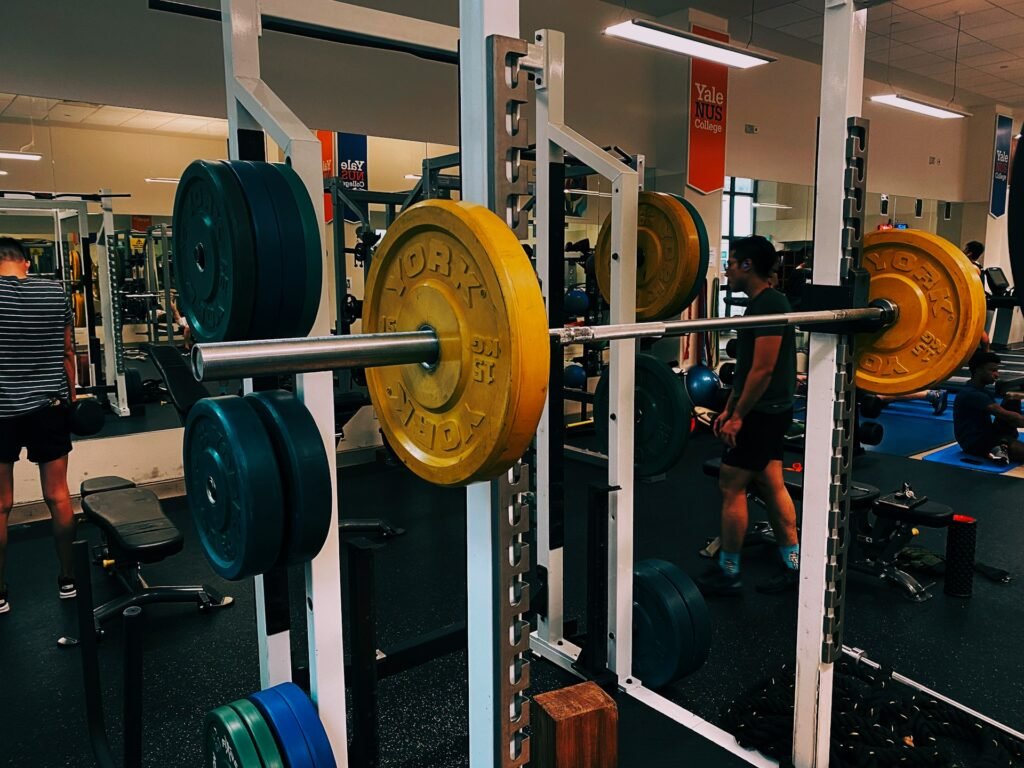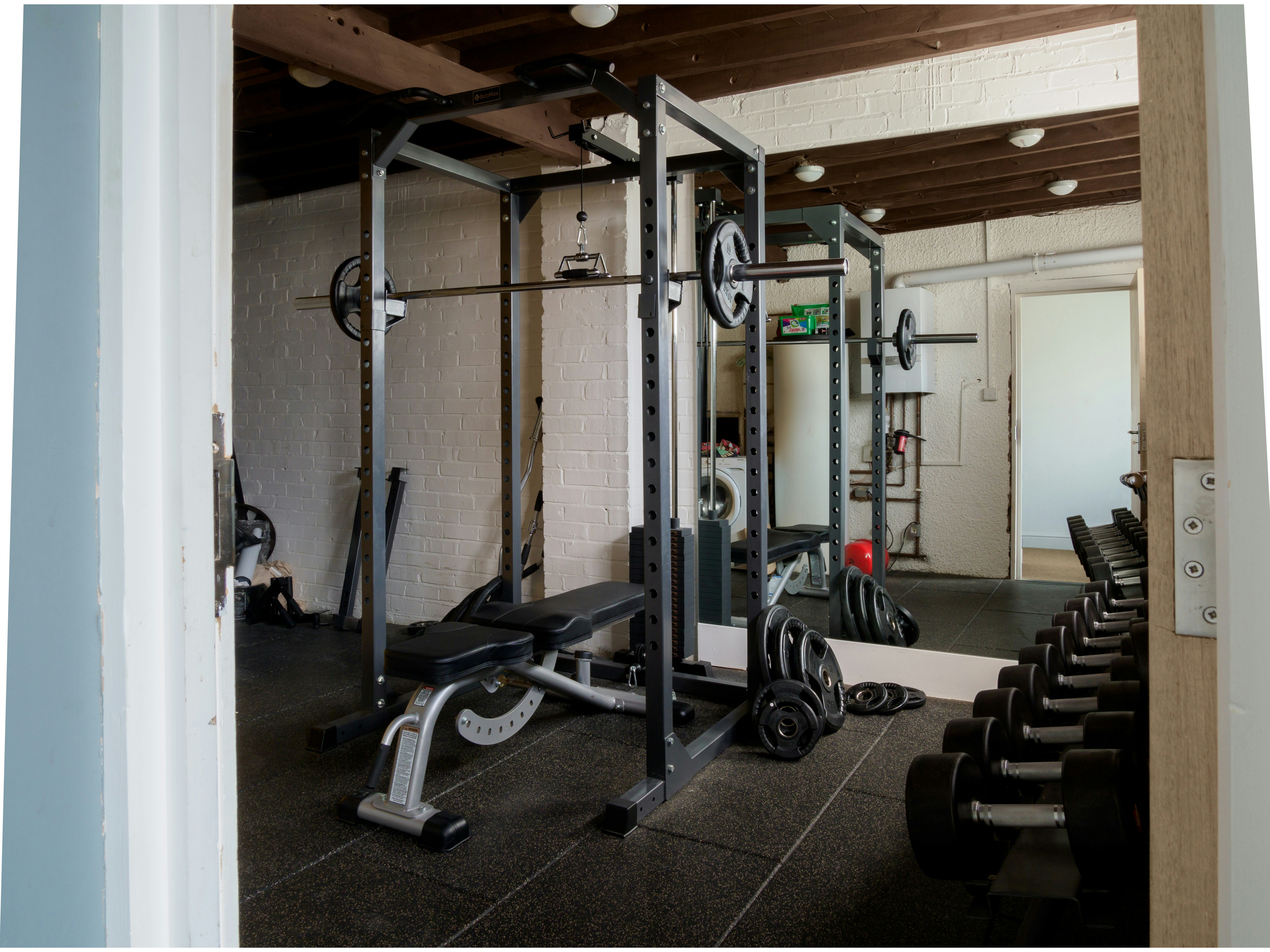
Photo by Keith Yap on Unsplash
When developing a strength training program, choosing the right equipment is crucial. Smith machines and barbells are two popular choices in many gyms, but they serve different purposes and offer unique advantages and disadvantages.
Smith machines consist of a barbell that is fixed within steel rails, allowing only vertical or near-vertical movement. This design helps reduce the risk of injury, making it safer for beginners or those lifting without a spotter. In fact, research has shown that Smith machines can be particularly beneficial for isolating muscle groups and performing higher-rep hypertrophy training [^1^]. Additionally, the Smith machine can mimic many free-weight exercises but with added stability and safety.
On the other hand, barbells provide a more functional and versatile workout option. They allow for a greater range of motion, requiring the activation of stabilizer muscles during exercises. This can lead to more effective overall muscle development. Studies have highlighted that free weights, including barbells, offer better muscle activation compared to machines like the Smith machine [^2^].
Comparing these two can help you understand which suits your workout goals better. Whether you aim for muscle isolation with added safety features or a more comprehensive workout that builds stabilizer muscles and functional strength, knowing the differences between Smith machines and barbells is essential for making informed decisions.
For more insights into building a well-rounded workout, you might find our guide on full-body barbell workouts helpful.
[^1^]: Grier, T., Brooks, R. D., Solomon, Z., & Jones, B. H. (2023). Injury Risk Factors Associated With Weight Training. J Strength Cond Res. [^2^]: Schwanbeck, S., Chilibeck, P. D., & Binsted, G. (2009). A comparison of free weight squat to Smith machine squat using electromyography. J Strength Cond Res.
Key Differences Between Smith Machines and Barbells
When comparing Smith Machines and barbells, several key differences come into play that can significantly impact your workout.
Stability and Safety: Smith Machines provide more stability because the barbell is fixed on a guided track. This can be especially beneficial for beginners who need extra help maintaining proper form. According to a study from the Journal of Strength and Conditioning Research, exercises performed on a Smith Machine can reduce the risk of injury by limiting the range of motion and adding stability (Journal of Strength and Conditioning Research, 2014). Conversely, barbells require you to balance the weight yourself, which engages more stabilizing muscles.
Range of Motion: Barbells offer a full range of motion, allowing for exercises that mimic natural body movements. In contrast, the Smith Machine confines you to a vertical or near-vertical plane, which can limit the effectiveness of certain exercises. For instance, studies show that free-weight squats activate around 43% more muscles in the legs compared to squats performed on a Smith Machine (Journal of Strength and Conditioning Research).
Versatility: Barbells are generally more versatile. You can perform a wider variety of exercises using a barbell, from deadlifts to overhead presses. While the Smith Machine can also be used for multiple exercises, its fixed path may not be suitable for all types of movements.
Targeted Muscle Activation: Using a Smith Machine tends to activate fewer stabilizing muscles. According to a study from the Journal of Sports Science and Medicine, free-weight bench presses activate 40% more stabilizing muscles than bench presses performed on a Smith Machine (Journal of Sports Science and Medicine). This means barbells can provide a more comprehensive workout, especially for those looking to build muscle mass and strengthen stabilizers.
If you’re curious about incorporating different types of resistance training into your routine, you might find our article on barbell workouts helpful.
Benefits of Using a Smith Machine
The Smith machine offers several advantages for both beginners and experienced gym-goers. One of its key benefits is the stability it provides. Unlike free weights, the Smith machine’s barbell moves along a fixed vertical track. This feature helps you maintain balance and focus solely on lifting, without worrying about the barbell moving sideways or falling forward or backward. This stability is advantageous when performing exercises like squats and bench presses, especially when using heavy weights [^1^].
Another significant benefit is safety. The Smith machine is equipped with multiple catch points along the rails. These safety catches allow you to lock the barbell at different heights, minimizing the risk of dropping the weight. This is especially useful for individuals who train alone and do not have a spotter [^1^].
The versatility of the Smith machine is another key advantage. It can be used for a wide range of exercises, targeting all major muscle groups. From squats and shoulder presses to lunges and calf raises, the Smith machine provides a comprehensive workout experience [^2^]. This versatility makes it a valuable addition to both personal and commercial gym settings.
Moreover, the Smith machine promotes good posture and proper form. The guided rails ensure that your movements are performed correctly, reducing the risk of injury. This feature is particularly beneficial for beginners who are still mastering their form. Research suggests that maintaining good form and posture during workouts can significantly enhance effectiveness and reduce injury risk [^3^].
Lastly, the Smith machine is accessible to all fitness levels. Beginners may appreciate the support and stability it offers, while advanced lifters can use it to focus on lifting heavier weights without compromising form or safety. This makes the Smith machine a versatile and practical piece of equipment for any gym [^1^].
If you are curious about other types of strength training equipment, you might find our guide on the benefits of using free weights insightful.
[^1^]: Fitness Gallery. [^2^]: Fitness Gallery. [^3^]: Smith, J. (2023). Proper form in resistance training. Strength and Conditioning Journal.
Advantages of Barbell Training

Photo by Brett Jordan on Unsplash
Barbell training is highly beneficial for individuals aiming for strength, muscle growth, and overall fitness improvement. One primary advantage is the ability to perform compound exercises, which work multiple muscle groups simultaneously. Exercises such as the barbell squat, deadlift, and bench press promote balanced muscular development and increase efficiency by engaging large parts of the body in a single movement.
Free movement is another key benefit of barbell exercises. Unlike machines, barbells allow a full range of motion, which is essential for enhancing functional strength and mobility. This unrestricted movement helps improve coordination and stability, mimicking real-life activities more closely. Studies have shown that barbell training can enhance core strength and stabilization muscles, which are crucial for everyday activities and injury prevention[^1^].
Furthermore, barbell training is adaptable to all fitness levels. By simply adjusting the weight plates, individuals can tailor their workouts to their strength and progression, making it an excellent choice for both beginners and advanced lifters. Research indicates that progressive overload, adding more weight over time, is effective in stimulating muscle growth and strength gains[^2^].
Additionally, barbell exercises are accessible and versatile. Most gyms are well-equipped with barbells and the necessary weights, and even home gym setups can easily accommodate them. This makes barbell training a cost-effective method for achieving various fitness goals.
If you’re interested in incorporating barbell training into your routine, consider exploring our full-body barbell workout for a comprehensive guide to get started.
[^1^]: MasterClass – Benefits of Barbell Exercises [^2^]: Source referencing the effectiveness of progressive overload.
Drawbacks of Smith Machines
Smith machines come with a few notable drawbacks that can impact your workout experience. Firstly, the bar on a Smith machine follows a fixed vertical path, limiting the range of motion. This can feel unnatural and uncomfortable for some users. According to Fitness Gallery, the inability of the bar to deviate from its fixed path can make it challenging to perform certain exercises correctly, reducing the versatility of the equipment.
Moreover, while the Smith machine does enhance safety by stabilizing the weight, it also minimizes the engagement of stabilizer muscles. This is crucial as these muscles play a significant role in overall strength and functional fitness. Studies suggest that free weight training activates more muscle groups compared to exercises performed on a Smith machine (Gulledge & Dugas, 2003).
Removing the barbell from a Smith machine can also be cumbersome, making it less user-friendly. It requires additional time and effort, which may disrupt the flow of your workout. Additionally, the machine’s design may limit the types of exercises you can perform safely. For instance, exercises requiring horizontal movement or exercises that demand a less rigid bar path, like deadlifts or certain bench press variations, are not ideally suited for Smith machines.
For more varied exercises and functional benefits, many fitness enthusiasts prefer using power racks or free weights. If you’re interested in learning how other types of equipment can complement your workout, you might find our article on steady state cardio examples insightful.
Limitations of Barbell Exercises
While barbell exercises are a common choice for strength training, they do come with several limitations. One significant drawback is the potential for increased muscle tension due to heavy lifting. Over time, this heightened tension can lead to issues with muscle elasticity and flexibility, which are crucial for athletic performance. For instance, javelin thrower Tero Pitkamaki struggled with rigidity due to excessive barbell work, which ultimately affected his performance (Just Fly Sports).
Another concern is the potential for injury when barbell exercises are performed incorrectly. Improper form can lead to imbalances, especially in the posterior chain if not addressed properly. This can result in poor posture and increased risk of injury to the lower back, knees, and shoulders.
Barbell exercises also require substantial skill and technique, which could be a barrier for beginners. Without proper guidance, new lifters might struggle with movements like squats and deadlifts, possibly leading to poor form and subsequent injuries.
Moreover, repetitive heavy lifting can lead to overtraining, putting excessive strain on the central nervous system (CNS). This fatigue can impede recovery, especially if not balanced with adequate rest and lighter training sessions.
Finally, barbell lifting tends to focus on bilateral exercises, which might not address muscle imbalances as effectively as unilateral (one-sided) exercises. This imbalance can hinder athletic performance, particularly in sports that require a high degree of agility and coordinated movements.
For those looking to incorporate more balanced and varied training methods, check out these dumbbell workouts for alternative strength-building exercises.
Final Verdict: Smith Machine or Barbell?
Deciding between the Smith machine and the barbell ultimately comes down to your personal goals and workout preferences. Smith machines offer stability and controlled movements, which can be beneficial for beginners or those looking to minimize injury risk. According to a study, using a Smith machine can result in better balance for novice lifters, as the machine’s fixed path reduces the chance of improper form [^1^]. Additionally, Smith machines are a great option when you don’t have a spotter, as safety mechanisms can prevent the bar from falling unexpectedly.
On the flip side, barbells offer a greater range of motion and engage more stabilizer muscles, making them ideal for building functional strength. Research shows that free weight exercises activate about 43% more muscle fibers compared to Smith machine exercises [^2^]. This means barbells can be more effective for those looking to maximize muscle hypertrophy and performance.
In summary, the choice between a Smith machine and a barbell depends on your fitness objectives and experience level. If you’re just starting out or need extra support due to injury, a Smith machine might be the right choice. For experienced lifters looking to challenge their stabilizer muscles and overall strength, barbells are likely a better fit.
For more information on different barbell exercises you can incorporate into your routine, check out our guides on back exercises with a barbell or full-body barbell workout.
[^1^]: Smith Machine vs Barbell [^2^]: Hack Squat vs Barbell Squat